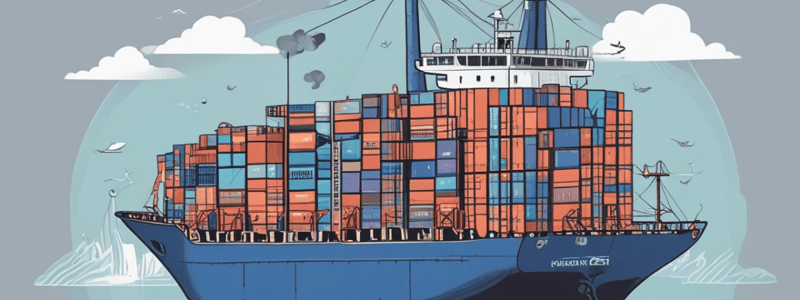Podcast
Questions and Answers
What is the purpose of the docker commit command?
What is the purpose of the docker commit command?
- To start a new container from a Docker image
- To list all running containers
- To create a new Docker image from a container's changes (correct)
- To push a Docker image to a registry
What is the purpose of the docker rm command?
What is the purpose of the docker rm command?
- To remove one or more containers (correct)
- To create a new container from an image
- To list all available Docker images
- To stop one or more containers
What is the purpose of the docker exec command?
What is the purpose of the docker exec command?
- To start a new container from a Docker image
- To run a command in a running container (correct)
- To push a Docker image to a registry
- To list all running containers
What is the purpose of the docker tag command?
What is the purpose of the docker tag command?
What is the purpose of the docker inspect command?
What is the purpose of the docker inspect command?
What happens when you execute the docker run command with the --rm option?
What happens when you execute the docker run command with the --rm option?
What is the difference between docker attach and docker exec?
What is the difference between docker attach and docker exec?
What is the purpose of the docker pause command?
What is the purpose of the docker pause command?
What is the function of the docker cp command?
What is the function of the docker cp command?
Which command is used to create a new image from a container's changes?
Which command is used to create a new image from a container's changes?
What does the docker volume command manage?
What does the docker volume command manage?
Which command lists all the running containers?
Which command lists all the running containers?
Which command allows you to view live logs from a container?
Which command allows you to view live logs from a container?
Which command removes unused data, such as stopped containers and dangling images?
Which command removes unused data, such as stopped containers and dangling images?
Flashcards are hidden until you start studying
Study Notes
Docker Command Purposes
- The
docker commitcommand is used to create a new image from changes made to a container. - The
docker rmcommand is used to remove one or more containers. - The
docker execcommand is used to run a command in a running container. - The
docker tagcommand is used to assign a name to an image, allowing it to be referred to by a more human-readable name. - The
docker inspectcommand is used to return low-level information about a container or image.
Docker Run Command Options
- When running the
docker runcommand with the--rmoption, the container is automatically removed when it exits.
Docker Attach and Exec
docker attachanddocker execare used to access a running container, but they differ in their behavior:docker attachattaches to a running container and allows you to see its output, but it does not allow you to interact with the container.docker execallows you to run a command in a running container and interact with it.
Docker Pause and Cp
- The
docker pausecommand is used to pause all processes in one or more containers, allowing for temporary suspension of the container. - The
docker cpcommand is used to copy files or folders from a container to the host machine or vice versa.
Docker Commands
- Docker commit command creates a new image from a container's changes.
- Docker rm command removes one or more containers.
- Docker exec command runs a command in a running container.
- Docker tag command creates a new reference to an image.
- Docker inspect command displays low-level information on Docker objects.
Docker Run Options
- Docker run command with the --rm option automatically removes the container when it exits.
Docker Interactions
- Docker attach command attaches to a running container, while docker exec command runs a command in a running container.
- Docker pause command pauses all processes in one or more containers.
Docker File Management
- Docker cp command copies files or folders between a container and the local file system.
Docker Image Management
- Docker commit command creates a new image from a container's changes.
Docker Volume Management
- Docker volume command manages Docker volumes, which allow data to be shared between containers.
Docker Container Management
- Docker ps command lists all the running containers.
- Docker logs command allows viewing live logs from a container.
- Docker system prune command removes unused data, such as stopped containers and dangling images.
Docker Commands
- Docker commit command creates a new image from a container's changes.
- Docker rm command removes one or more containers.
- Docker exec command runs a command in a running container.
- Docker tag command creates a new reference to an image.
- Docker inspect command displays low-level information on Docker objects.
Docker Run Options
- Docker run command with the --rm option automatically removes the container when it exits.
Docker Interactions
- Docker attach command attaches to a running container, while docker exec command runs a command in a running container.
- Docker pause command pauses all processes in one or more containers.
Docker File Management
- Docker cp command copies files or folders between a container and the local file system.
Docker Image Management
- Docker commit command creates a new image from a container's changes.
Docker Volume Management
- Docker volume command manages Docker volumes, which allow data to be shared between containers.
Docker Container Management
- Docker ps command lists all the running containers.
- Docker logs command allows viewing live logs from a container.
- Docker system prune command removes unused data, such as stopped containers and dangling images.
Studying That Suits You
Use AI to generate personalized quizzes and flashcards to suit your learning preferences.




